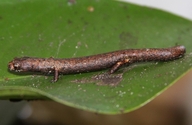|
Bolitoglossa paraensis (Unterstein, 1930)
Subgenus: Eladinea | family: Plethodontidae subfamily: Hemidactyliinae genus: Bolitoglossa |
| Species Description: Unterstein, W. 1930. Beschreibung zweier neuer Molche der Gattung Oedipus. Zoologischer Anzeiger 87: 270–272. | |
 © 2008 Selvino Neckel (1 of 10) |
|
|
|
Description DIAGNOSIS: Bolitoglossa paraensis can be distinguished from other species due to its extensive digital webbing, 13 costal grooves, and the absence of a sublingual fold. Compared to other members of the genus Bolitoglossa, B. paraensis is small and slender (Brcko et al. 2013). COLORATION: In life, the dorsal surface of the body is gray with blotches of light or dark brown. There are also white spots along the body and flanks. The ventral surface is dark gray with evenly distributed white spots. The snout has cream blotches between the nostrils and above the nasolabial protuberance. The tail is lighter than the back, and is brownish with white spots on both the dorsal and lateral surfaces. The iris is pale golden and the mental gland is whitish (Brcko et al. 2013). In preservative, the dorsal surface of the head and body are dark gray with reddish brown blotches. Some specimens have uniform coloration while others are mottled or with a mid-dorsal stripe. The ventral surface is light brown with evenly distributed cream spots. The snout is cream or has cream blotches between the nostrils and above the nasolabial protuberance. Most specimens have a triangular dark brown marking between the eyes. The mental gland is apparent and cream colored (Brcko et al. 2013). Distribution and Habitat Country distribution from AmphibiaWeb's database: Brazil
Life History, Abundance, Activity, and Special Behaviors They are typically found on the leaves of small shrubs 0.3 - 2.6 m above the ground, but may also live in leaf litter and in the bark of trees. They are found in a variety of vegetation types such as primary terra firme forest, secondary forest, floodplain forest, and igapó, capoeira. But they can also be found in agricultural areas such as monocultures of passion fruit (Passiflora edulis), cocoa (Theobroma cacao), and African oil palm (Elaeis guineensis) (Brcko et al. 2013). They are active mostly during the rainy months of December to March (Neckel-Oliveira et al. 2011, Brcko et al. 2013). Life history patterns, such as breeding, are heavily influenced by ecological factors, specifically climate. Reproductive activity is likely triggered by increased precipitation or humidity. Clutch size varies from 8 -14 eggs (Neckel-Oliveira et al. 2011). Members of Bolitoglossa lay eggs that hatch into metamorphosed juveniles (Neckel-Oliveira et al. 2011). Larva Trends and Threats Possible reasons for amphibian decline General habitat alteration and loss Comments
References
Brcko, I. C., Hoogmoed M., Neckel-Oliviera, S. (2013).“Taxonomy and Distribution of the Salamander Genus Bolitoglossa Duméril, Bibron & Duméril, 1854 (Amphibia, Caudata, Plethodontidae) in Brazilian Amazonia.” Zootaxa 3686, 4, 401-431 [link] Neckel Oliveira, S. Hoogmoed, M.S. (2010). "Bolitoglossa paraensis." The IUCN Red List of Threatened Species 2010: e.T135735A4195091. https://dx.doi.org/10.2305/IUCN.UK.2010-2.RLTS.T135735A4195091.en. Accessed on 24 August 2022. Neckel-Oliveira, S., Sarmento, J. F. M., Galatti, U., Suárez, P., Lima, C., Lima, A. A., Fáveri, S. B. (2011). "Reproductive traits of the Brazilian salamander Bolitoglossa paraensis (Urodela: Plethodontidae)." Copeia 2011(3), 457-462 [link] Originally submitted by: Jacob Scheer (2022-08-25) Description by: Jacob Scheer (updated 2022-08-25)
Distribution by: Jacob Scheer (updated 2022-08-25)
Life history by: Jacob Scheer (updated 2022-08-25)
Larva by: Jacob Scheer (updated 2022-08-25)
Trends and threats by: Jacob Scheer (updated 2022-08-25)
Comments by: Jacob Scheer (updated 2022-08-25)
Edited by: Ann T. Chang (2022-08-25) Species Account Citation: AmphibiaWeb 2022 Bolitoglossa paraensis <https://amphibiaweb.org/species/6407> University of California, Berkeley, CA, USA. Accessed Nov 4, 2024.
Feedback or comments about this page.
Citation: AmphibiaWeb. 2024. <https://amphibiaweb.org> University of California, Berkeley, CA, USA. Accessed 4 Nov 2024. AmphibiaWeb's policy on data use. |



 Raffaëlli Account
Raffaëlli Account Map of Life
Map of Life